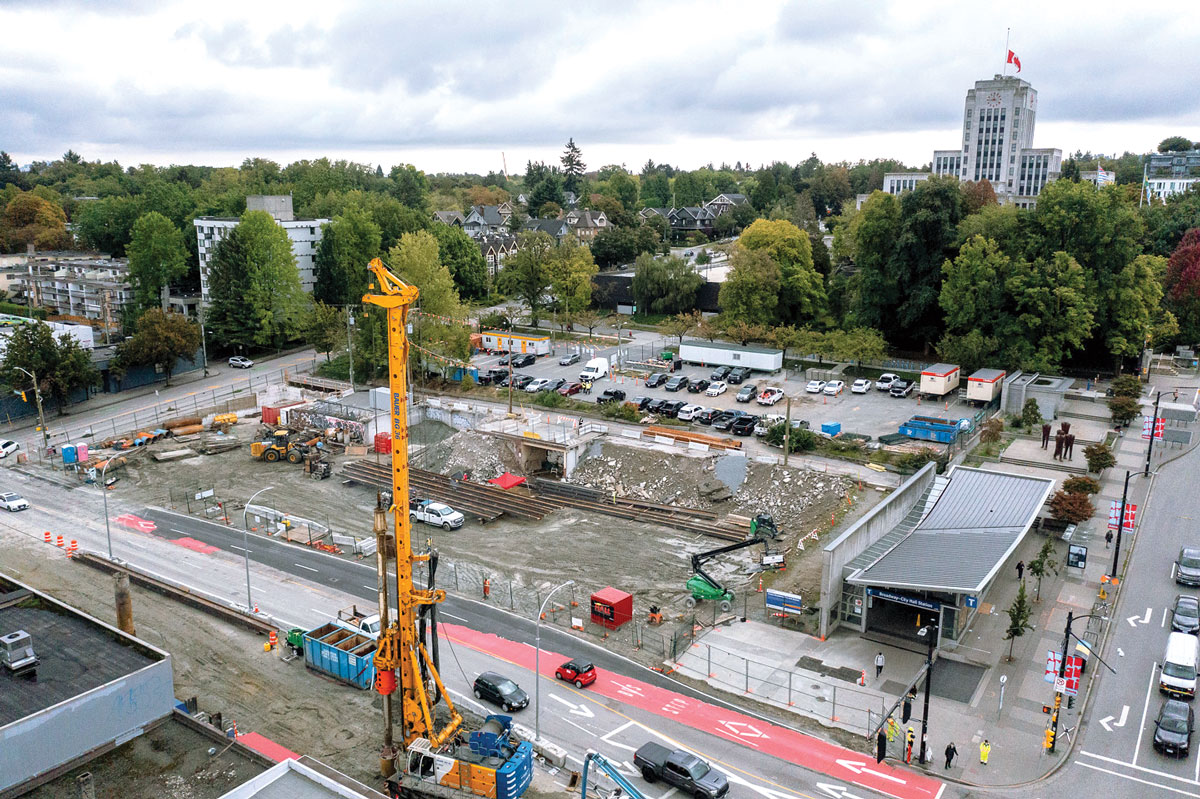
For years, walking out of Vancouver’s Commercial-Broadway SkyTrain Station to travel west on Broadway by way of the 99 B-Line bus has been an unenviable task. It’s not uncommon for commuters to watch two, three or four buses pass by before they get to board. For Vancouverites, it’s just another day on one of the busiest bus routes in Canada and the U.S., with an average of 55,900 passengers every weekday. Thankfully relief is coming.
In 2025, a 5.7 kilometre subway extension of the SkyTrain’s Millennium Line that runs east-west along Broadway, from VCC-Clark station to the intersection of West Broadway and Arbutus Street, will open to the public. The goal of the project is to relieve congestion on the Broadway-Commercial transit hub and its various outflows, including the 99 B-Line, where it will provide three times the capacity of that bus route.
Currently under construction, the officially titled “Broadway Subway Project” is a partnership between the municipal, provincial and federal governments to the tune of $2.83 billion. Breaking it down, that’s just over $1.8 billion from the province, just under $900 million from Canada, and almost $100 million of land in kind from the City of Vancouver.
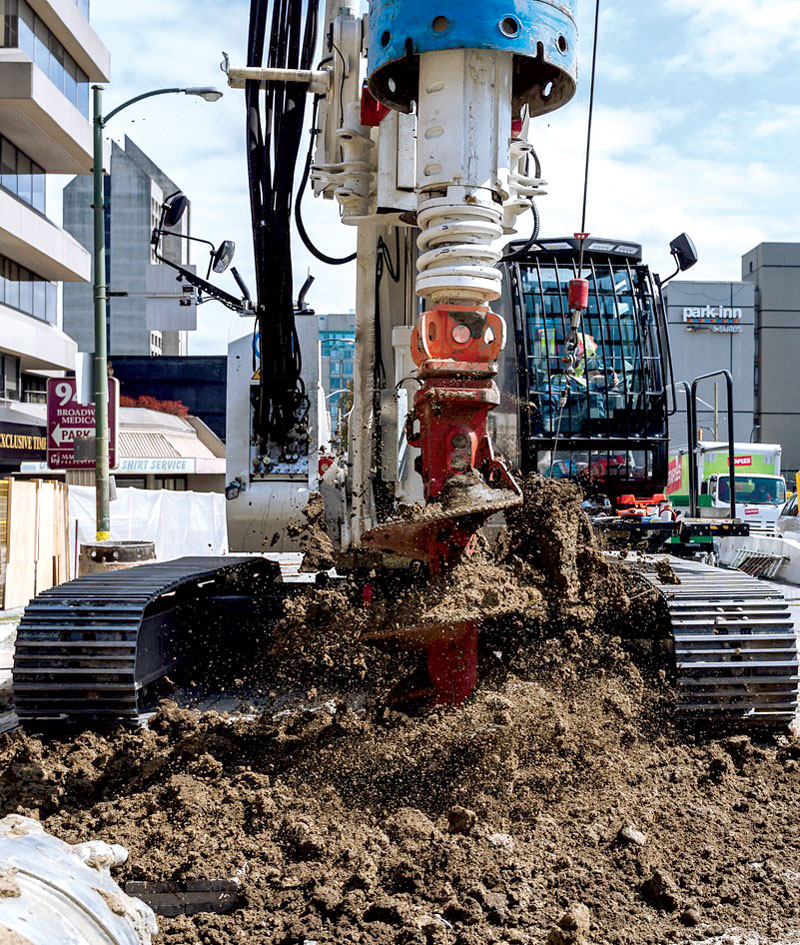
This SkyTrain extension includes a 700-metre transition from the elevated VCC-Clark station to an underground station at Great Northern Way before tunneling under Broadway for the remaining five kilometres. Along the route, there will be six new subway stations including an underground connection to the existing Broadway-City Hall station, so commuters can transfer to the Canada Line, which terminates at the Vancouver International Airport.
On its own it would be a massive undertaking, but, adding to the challenge, the project’s construction crews signed a contract saying they would maintain traffic flow during construction.
“The biggest challenge is to keep traffic moving along Broadway at all times during all phases of construction. So we have to find ways of building these underground stations along Broadway without interrupting traffic flow,” said Jeff Spruston, project representative of the Broadway Subway Project Corporation, the design-build-finance partnership of Acciona and Ghella.
To do this, temporary bridges called traffic decks are being built over top of the station locations on Broadway. The traffic decks alone require multiple phases of construction and large, heavy structures to carry the traffic once installed. However, when complete, crews will be able to ensure mobility along the corridor with a consistent four-lane, at-grade traffic configuration, while construction is carried out below.
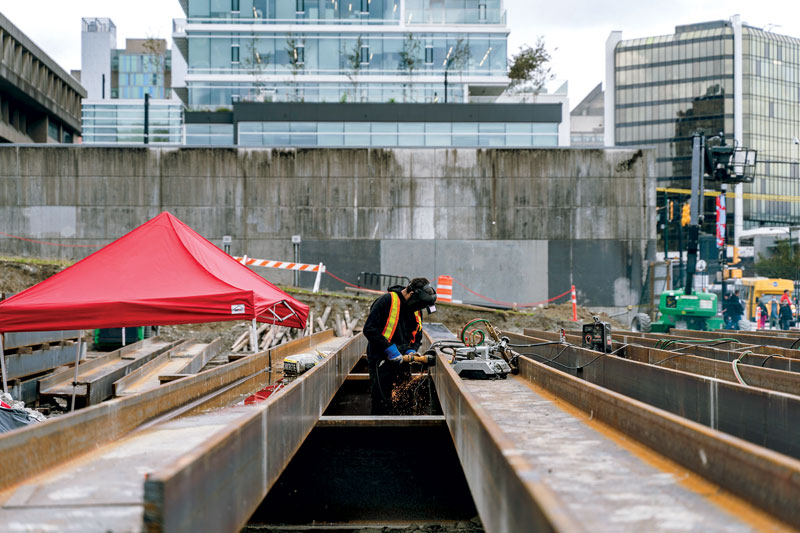
“This is the first time these traffic decks have been used on a large-scale in Vancouver. They had been used locally during Canada Line construction in Yaletown, but this is the first time they are being used along an entire corridor and that’s where a lot of the drilling and piling for this project comes in,” said Spruston.
As of this writing, the project was in the very early stages of installing these traffic decks. Crews from Soletanche Bachy Canada and Henry Foundation Drilling, Inc., have completed piling in the Mount Pleasant and Broadway-City Hall areas and piling is underway at the remaining three stations along Broadway. The first traffic decks are being installed and are expected to go into service this year.
GFL Environmental, Inc., was awarded the contract to install the 168 permanent piles for the elevated guideway, part of the traffic decks and some transition structures leading from the elevated structures down to the underground tunnels.
The entire piling operation is executed using Bauer and Soilmec rigs to drill 520 temporary piles that are 900 millimetres in diameter, 25 to 30 metres deep. The subcontractors then slide an I-beam down each hole and back-fill with concrete to create a structural column that’s imbedded in the bedrock.
The first traffic decks are being installed and are expected to go into service this year.
“Overall, we would say that the drilled pile installation has gone very smoothly, but obviously if you talk to the companies that are performing that work and the crews that are out there every day, there are lots of challenges to be aware of, including underground utilities and the work’s proximity to businesses and sidewalks,” said Spruston.
“We’re keeping all the business access and we’re keeping all the sidewalks open throughout our activities, which often require very large drill rigs and piling rigs set up less than one metre from operating sidewalks. This underlines the importance of our commitment to public and crew safety, cleanliness and noise control during construction activities.”
It might sound like a tall order to keep all of that under control, but with Broadway running six lanes of traffic, three in each direction, it’s relatively easy to create a safely barriered work zone with concrete barriers and segregated fencing on the north side of the street, while shifting traffic to the south side lanes. Then, once the north side piles are complete, crews will do the reverse by shifting the traffic to the north side lanes overnight and completing work under the south side of the street.
All the while, pedestrian paths to businesses are fenced off from the work zone on both sides and drilling work is done during the day to reduce noise pollution during evening hours.
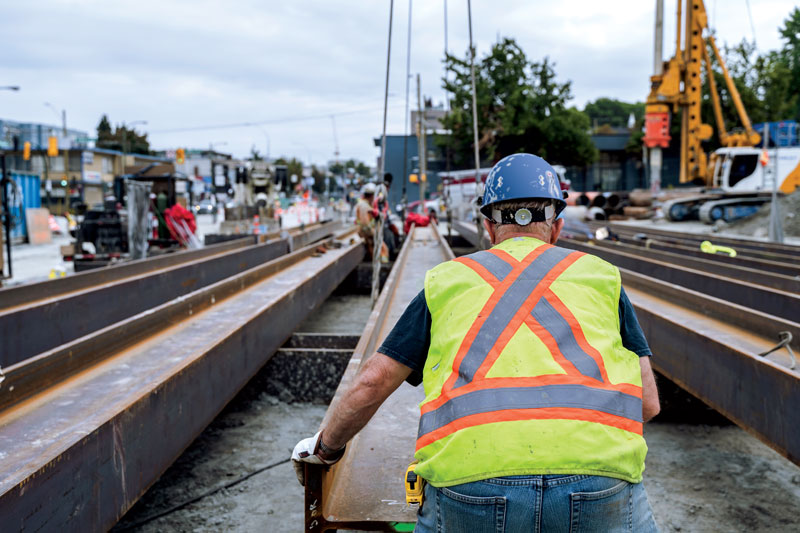
“I think crews are doing an excellent job out there and they absolutely have their challenges from hour to hour and day to day. But, in the overall scheme, things are going smoothly, our productivity on the pile installation is where we need it to be, and we’re working long shifts and weekends to make sure things go the way they need to go,” said Spruston.
Despite some noise and minor inconveniences, Vancouver residents and businesses along Broadway are largely supportive of the SkyTrain expansion, knowing the many benefits the project will bring over the long-term when its finally complete three years from now. Add to that, the municipal government’s own sizeable contribution and its clear no one can wait for 2025.
“The City of Vancouver is probably unique, given the substantial amount of contribution they’ve made to this project. Over the last five to 10 years, the city has been acquiring land for those stations and for laydown areas, which is unusual. Generally, municipalities don’t do that, but the City of Vancouver was obviously very motivated to have this extra infrastructure within their community,” said Lisa Gow, executive project director of the Broadway Subway Project for the province.
The SkyTrain expansion also promises to reduce greenhouse gas emissions since TransLink has promised to use hybrid buses on that route.
In addition to the reduction of transit congestion along the Broadway corridor, fewer bus kilometres will be used since 99 B-Line buses will travel from the new Arbutus Station out to the University of British Columbia, instead of the current longer route. The SkyTrain expansion also promises to reduce greenhouse gas emissions since TransLink has promised to use hybrid buses on that route. Plus, with the connectivity that will be offered to the rest of the transit system, people that are currently driving may switch to the transit system. Meanwhile, the transit system as it currently operates has experienced few interruptions due to the construction along the Broadway corridor.
“When [Spruston] talks about the number of lanes that need to be left open on Broadway during construction, the key driver for that, and for the approach that they’re taking during construction, was to ensure that we could keep the same level of actual transit activity, with the 99 B-Line and the 9, along Broadway happening throughout construction,” said Gow.
“We also did move three routes in advance of construction. The 14, 16 and 17 were removed from Broadway and put on alternative corridors to make sure that we could continue to have that full transit capacity.”
The construction crews are also doing their part for the environment by following proper soil and contaminant disposal techniques, as well as working with three First Nations communities to ensure that no possible archaeological artifacts are disturbed during construction. As of this article, no artifacts have been found.
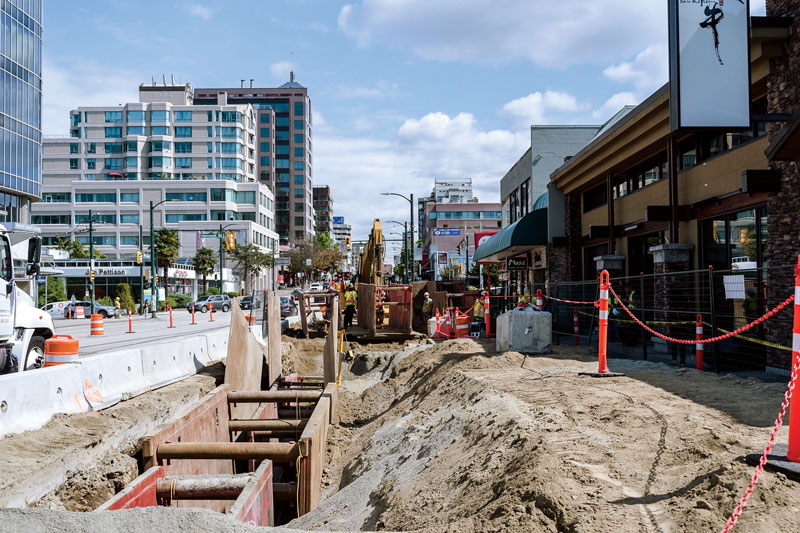
Already a big project with many moving parts, stakeholders and special considerations, Spruston, Gow and their crews have only just begun. Next on the agenda, starting this year and finishing by 2023, is the use of two earth pressure balance tunnel-boring machines to dig the five kilometres of tunnel under Broadway. Also beginning this year and continuing into 2024, is the construction of the stations with accompanying track, electrical and ventilation systems being installed simultaneously.
“It’s just a constant attention to detail that we’re focused on,” said Spruston. “We have a really good safety culture on the project. Both ourselves and the province are well aligned. Such attention to detail is taxing in one regard, we have a team that maintains safety protocols each and every day, and they have to be alert to changes on-site. On the other hand, when we know safety has been taken care of thoroughly and properly, it’s easier to focus on getting the work done in a safe manner.”
Safety is always the No. 1 priority, but especially on a project as high profile as this, the biggest Spruston and Gow have ever been a part of. Their teams and the subcontracted piling crews have taken it on with gusto and the utmost professionalism, motivated by a better future for the surrounding community.
“This is a great project,” said Gow. “This project has a lot of benefits to the local community, and it’s well supported by the City of Vancouver and the residents, both along the corridor and in this area in general because of the connectivity to the rest of the system. It’s a career high for me.”